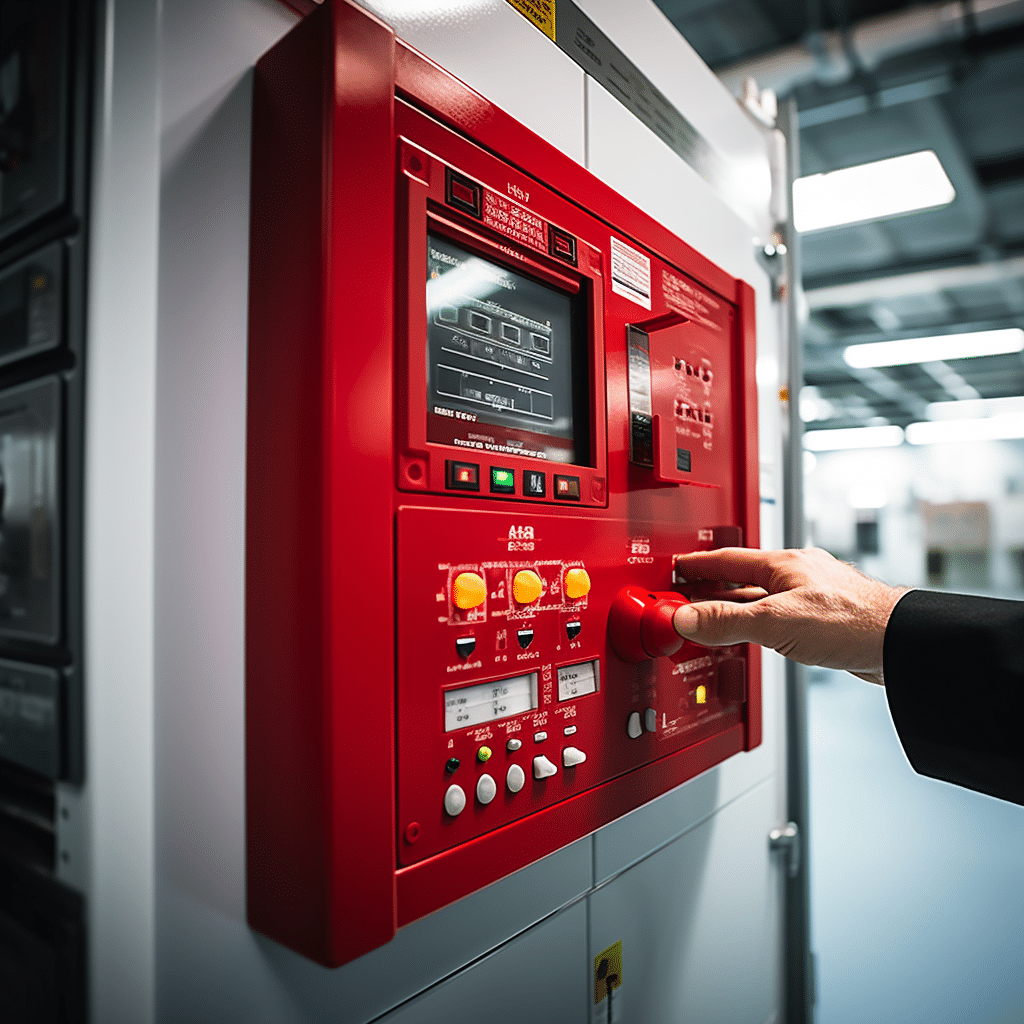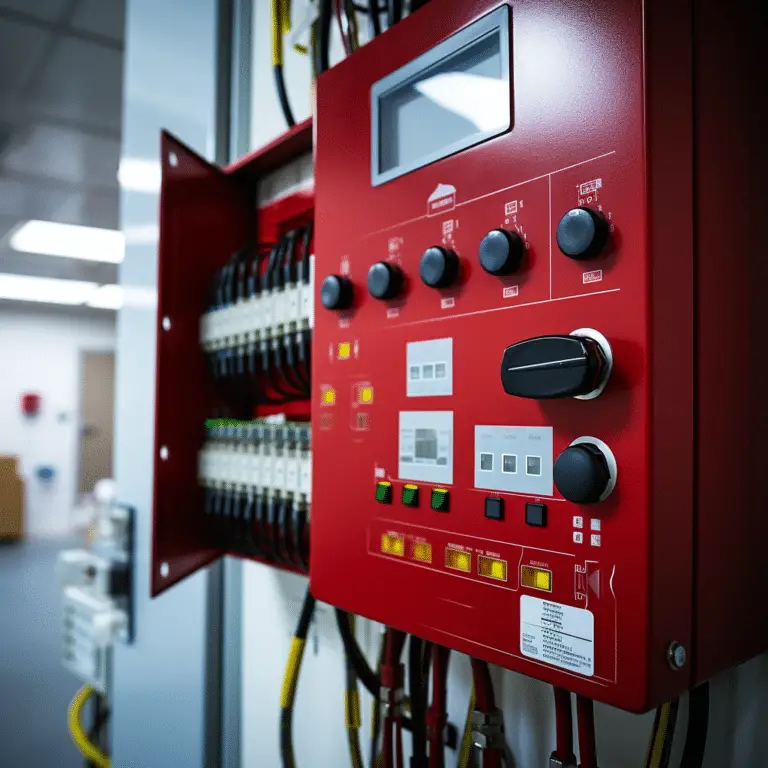Introduction
How To Use Fire Alarm Control Panel: The Fire Alarm Control Panel serves as the nerve center of a fire protection network, providing real-time information and control over various fire detection devices, such as smoke detectors, heat sensors, and manual pull stations. This guide aims to provide you with a comprehensive introduction to effectively using a Fire Alarm Panel. Whether you’re a building manager, a security professional, or someone interested in enhancing their fire safety knowledge, understanding how to operate a FACP is essential.
By learning the basics of navigation, status interpretation, and response protocols, you’ll be better equipped to respond to potential fire emergencies swiftly and efficiently. Throughout this guide, we will explore the fundamental functions of a Fire Alarm Control Panel, including how to interpret its indicators, acknowledge alarms, perform system tests, and manage user interfaces.
By the end, you will have gained a solid foundation in using a FACP to safeguard lives, property, and peace of mind. Remember, proper usage of a Fire Alarm Control Panel requires a combination of knowledge, preparedness, and quick decision-making. Whether in residential, commercial, or industrial settings, the ability to effectively utilize a FACP can make a significant difference in preventing fire-related disasters and ensuring the safety of all occupants.
How does a fire alarm control panel work?
The panel receives information from devices designed to detect and report fires, monitors their operational integrity, and provides for automatic control of equipment, and transmission of information necessary to prepare the facility for fire based on a predetermined sequence.
Activation: When a fire alarm is triggered, either by manual intervention or the detection of smoke or heat, an electrical signal is sent to the sounder.
Electrical Current: The sounder receives this electrical current and converts it into mechanical vibrations.
Mechanical Vibrations: These vibrations cause a diaphragm or a membrane within the sounder to oscillate rapidly. This oscillation displaces the air molecules around the diaphragm.
Air Compression: As the diaphragm moves back and forth, it alternately compresses and rarefies the air molecules in its vicinity, creating a sequence of high-pressure and low-pressure regions in the air.
Propagation of Sound Waves: The alternating pressure changes travel outward from the sounder in all directions as longitudinal waves, commonly known as sound waves.
Audible Perception: These sound waves reach our ears and cause our eardrums to vibrate in resonance with the incoming vibrations.

How do you use a fire alarm box?
Fire alarm pull stations are typically red boxes that say “FIRE” at building exits and stairwell doors. In case of fire or smoke, pull it down as indicated to activate the building fire alarm system where provided.
Locate the Fire Alarm Box
Fire alarm boxes are strategically placed in easily accessible areas throughout buildings and public spaces. These locations often include corridors, stairwells, lobbies, and near exits. Familiarize yourself with the placement of fire alarm boxes in your environment to ensure quick access during emergencies.
Assess the Situation
Before activating a fire alarm box, it’s essential to assess the situation to determine whether there is a genuine emergency. If you detect signs of fire, smoke, or other hazardous conditions, proceed to the next step.
Lift the Protective Cover
Most fire alarm boxes are equipped with a protective cover to prevent accidental activation. Lift the cover to reveal the alarm mechanism beneath.
How do you read a fire alarm panel?
Instructions
- Green Light Normal — Power is on and the Fire Alarm System is operating normally.
- Red Light Alarm — A zone or device is in alarm.
- Yellow Light Supervisory — The fire alarm system is indicating another system that is not normal and is in immediate need of attention.
Zone Indicators:
Fire alarm panels have zones that represent different areas of a building. Each zone has fire detection devices like smoke detectors and heat sensors. The panel shows which zone has been triggered with lights or numbers. This helps you know where the fire or emergency is.
Trouble and Supervisory Signals:
Apart from fire-related signals, fire alarm panels also monitor the system’s overall health. Trouble and supervisory signals indicate issues such as low battery voltage, sensor malfunctions, or communication problems. These signals are important because they alert you to potential problems that could impact the system’s effectiveness.
Alarm Signals:
When a fire detection device within a particular zone is activated, the corresponding zone indicator will light up or display a numeric value. Additionally, an audible alarm might sound to alert occupants. The fire alarm panel will display the specific zone(s) in alarm mode, helping you quickly identify the affected area.
What are the 3 main types of fire alarms?
A “Dual Sensor” smoke alarms contains both technologies and offers the best protection. There are three types of smoke alarms, ionization, photoelectric and a combination of the two which is commonly called a “dual” detector. Look for the UL stamp on any smoke alarm.
Ionization Smoke Alarms:
Ionization smoke alarms detect fast-burning fires with small smoke particles using a small amount of radioactive material between two charged plates. When smoke enters, it triggers an alarm by disrupting the ion flow. These alarms are sensitive to flames and can detect quickly developing fires with minimal smoke.
Photoelectric Smoke Alarms:
Photoelectric smoke alarms, also known as optical smoke alarms, excel at detecting slow-burning, smoldering fires that produce larger smoke particles. These alarms work by emitting a beam of light within a sensing chamber. When smoke enters the chamber, the light is scattered onto a sensor, triggering the alarm. Photoelectric alarms are known for their effectiveness in detecting fires that start with a smoldering phase, often producing significant smoke before the flames become apparent
Combination Smoke and Carbon Monoxide Alarms:
Combination smoke and carbon monoxide (CO) alarms offer a comprehensive approach to safety by detecting both smoke and the deadly gas carbon monoxide. Carbon monoxide is a colorless, odorless gas produced by incomplete combustion of fuel sources. Combination alarms incorporate both ionization and photoelectric smoke detection technologies, along with a CO sensor. When either smoke or elevated CO levels are detected, these alarms sound an alert.
What are the buttons on a fire alarm?
Press the hush/silencing button. It will silence the entire interconnected system. The button may also say “test.” It should silence all the alarms immediately unless there’s still smoke and debris. It will reset in eight minutes, given that the smoke and debris have dissipated.
Alarm Silence Button
The alarm silence button is a vital feature that allows authorized personnel to temporarily silence the audible alarms. This action is often necessary during situations where a false alarm has been triggered, and it’s important to restore a quiet and controlled environment. It’s crucial to note that silencing the alarm does not deactivate the entire fire alarm system; it only stops the audible alert for a predetermined period.
Alarm Reset Button
The alarm reset button is used after the cause of an alarm has been addressed and resolved. Once authorized personnel confirm that the environment is safe and the issue has been rectified, the alarm reset button can be pressed to reset the system. This step reactivates the fire alarm system, ensuring that it’s prepared to respond to any new emergency situations.
Test Button
The test button on a fire alarm is employed to assess the functionality of the system’s components, such as smoke detectors, sounders, and visual indicators. Regular testing is essential to verify that the devices are working properly and that the communication between the alarm panel and the devices is operational. Fire alarm systems often include specific protocols for conducting tests safely and without triggering false alarms.
What is an alarm system control panel?
Simply put, an alarm control panel is a device that is usually installed on the wall to give controllers complete access to an alarm system. With that being said, an alarm controller for gas detection systems enables engineers the ability to maintain a number of gas detectors from one centralized location.
The control panel is designed to integrate with a diverse range of sensors, detectors, and devices that monitor various threats. These may include motion detectors, door/window contacts, smoke detectors, heat sensors, glass break detectors, and more. When a sensor detects an unusual event, it sends a signal to the control panel for assessment.
Upon receiving signals from sensors, the control panel processes the information to determine the nature and severity of the threat. It evaluates whether the detected event warrants activating an alarm, sending notifications, or initiating a predefined response protocol.
Alarm systems have control panels with visual and audible alerts to show the system’s status. LED lights and alarms are used for this purpose. These systems can also communicate with remote monitoring centers, users, and emergency services through different networks. The control panel is user-friendly and allows interaction with the system, including arming or disarming it, acknowledging alarms, testing, and managing user access.
What is fire alarm indicator?
The cellular fire alarm communicator alerts the central monitoring station in the case of a fire. If you use a cellular fire alarm communicator instead of a landline fire alarm communicator, the system is connected through cell towers rather than phone lines.
A fire alarm indicator is a visual component integrated into fire alarm systems that conveys vital information through illumination. These indicators are strategically placed throughout buildings and public spaces to ensure their visibility to occupants and emergency responders. The primary purpose of a fire alarm indicator is to offer clear, immediate, and unambiguous cues about the status of the fire alarm system and the presence of potential hazards.
How does a fire alarm beep?
Smoke alarms alert you with three beeps in a row. Carbon monoxide alarms alert you with four beeps. A single chirp means the battery is low or the detector should be replaced.
Fire alarms beep because of vibrations. When a fire alarm goes off, vibrations are created that travel through the air as sound waves. An electric current is sent to a component called a sounder or speaker, which has a part called a diaphragm or membrane that starts to move quickly. This movement creates alternating high-pressure and low-pressure regions in the air, forming longitudinal sound waves. These sound waves travel in all directions and cause the air molecules they encounter to vibrate similarly to the diaphragm’s movement.
We hear sounds through our ears and brain. The frequency and intensity of the vibrations create the pitch and volume of the beep. Fire alarms use high-frequency sound waves to make a sharp and attention-grabbing beep. Different beep patterns can convey extra information, like low battery levels or the need for evacuation.

Conclusion
The FACP is important in preventing fires. This guide teaches how to use it effectively to protect people and property. Fire alarms and safety systems use technology, engineering, and science to make the world safer. Fire alarms are crucial in homes, businesses, and factories to keep people and property safe.
We can respond better to emergencies and protect our communities if we know about fire alarms. Understanding fire alarm components, how they work, and their alerts can help. We should remember this and promote fire safety and preparedness for everyone’s well-being.
Armed with the ability to interpret status indicators, acknowledge alarms, and conduct system tests, you have acquired a skill set that can make a significant impact during critical moments. Your mastery over the FACP empowers you to be a proactive force against potential Alarm Control fire emergencies, whether you’re responsible for a residential dwelling, a bustling commercial complex, or an expansive industrial site. It’s worth emphasizing that your commitment to understanding and utilizing the FACP is an investment in the well-being of those who inhabit and frequent the spaces under your care. By harnessing this technology, you contribute to a safer, more prepared society that can effectively respond to fire incidents with confidence and competence.

